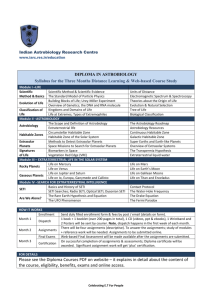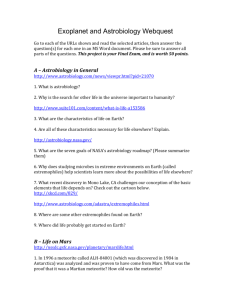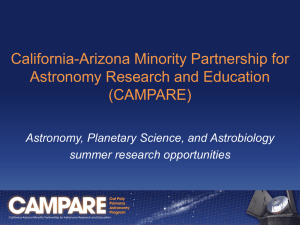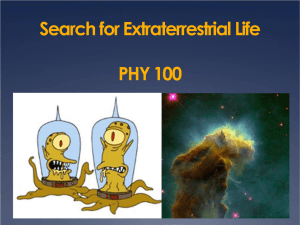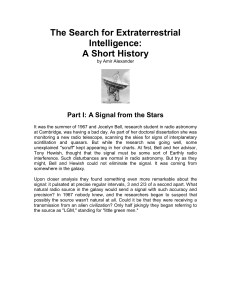INTERNET RESOURCES 1. Exoplanet Web Pages and Links
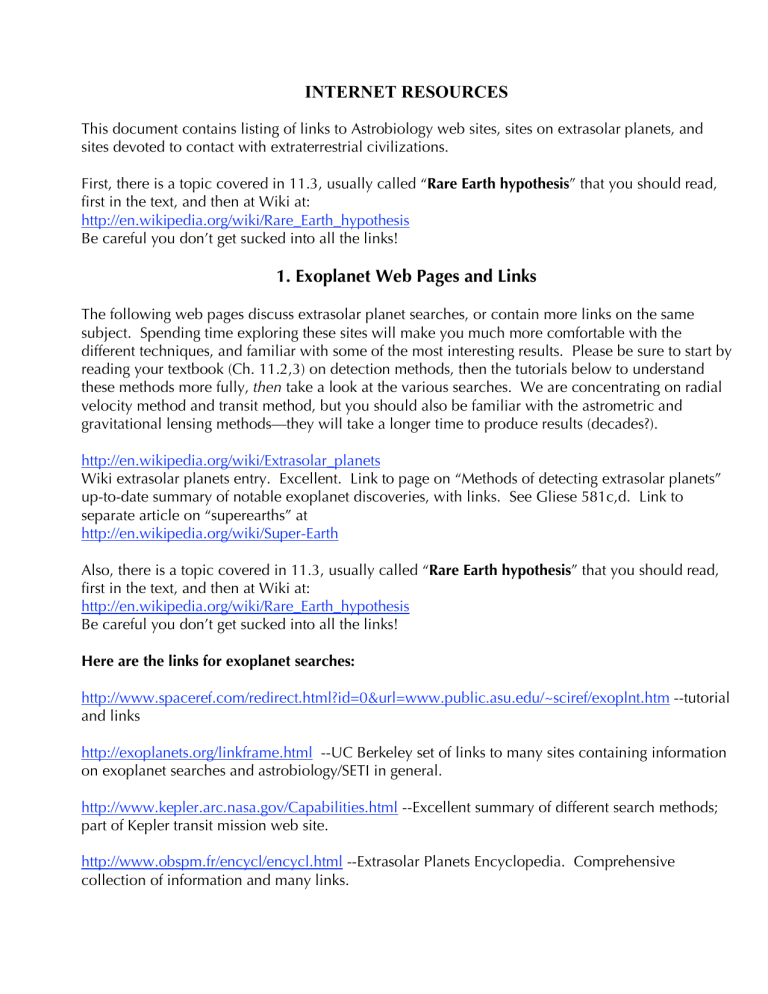
INTERNET RESOURCES
This document contains listing of links to Astrobiology web sites, sites on extrasolar planets, and sites devoted to contact with extraterrestrial civilizations.
First, there is a topic covered in 11.3, usually called “ Rare Earth hypothesis ” that you should read, first in the text, and then at Wiki at: http://en.wikipedia.org/wiki/Rare_Earth_hypothesis
Be careful you don’t get sucked into all the links!
1. Exoplanet Web Pages and Links
The following web pages discuss extrasolar planet searches, or contain more links on the same subject. Spending time exploring these sites will make you much more comfortable with the different techniques, and familiar with some of the most interesting results. Please be sure to start by reading your textbook (Ch. 11.2,3) on detection methods, then the tutorials below to understand these methods more fully, then take a look at the various searches. We are concentrating on radial velocity method and transit method, but you should also be familiar with the astrometric and gravitational lensing methods—they will take a longer time to produce results (decades?). http://en.wikipedia.org/wiki/Extrasolar_planets
Wiki extrasolar planets entry. Excellent. Link to page on “Methods of detecting extrasolar planets” up-to-date summary of notable exoplanet discoveries, with links. See Gliese 581c,d. Link to separate article on “superearths” at http://en.wikipedia.org/wiki/Super-Earth
Also, there is a topic covered in 11.3, usually called “ Rare Earth hypothesis ” that you should read, first in the text, and then at Wiki at: http://en.wikipedia.org/wiki/Rare_Earth_hypothesis
Be careful you don’t get sucked into all the links!
Here are the links for exoplanet searches: http://www.spaceref.com/redirect.html?id=0&url=www.public.asu.edu/~sciref/exoplnt.htm
--tutorial and links http://exoplanets.org/linkframe.html
--UC Berkeley set of links to many sites containing information on exoplanet searches and astrobiology/SETI in general. http://www.kepler.arc.nasa.gov/Capabilities.html
--Excellent summary of different search methods; part of Kepler transit mission web site. http://www.obspm.fr/encycl/encycl.html
--Extrasolar Planets Encyclopedia. Comprehensive collection of information and many links.
http://exoplanet.eu/searches.php -- Aug.2008
links to all ongoing exoplanet search projects. http://www.obspm.fr/encycl/sites.html
--from the Extasolar Planets Encyclopedia, many links to ongoing or upcoming search projects, very up-to-date. http://planetquest.jpl.nasa.gov/ --Jet Propulsion Laboratory/NASA exoplanet site, specializing in
Keck, SIM, and TPF interferometer missions, but links to many more. http://ast.star.rl.ac.uk/darwin/searches.html
--Darwin space interferometer page, with connections to virtually all planet search programs. http://planetquest.jpl.nasa.gov/ --Jet Propulsion Laboratory/NASA exoplanet site, specializing in
Keck, SIM, and TPF interferometer missions. Try linking through most recent blurb at http://planetquest.jpl.nasa.gov/news/300Beyond.cfm
http://www.hao.ucar.edu/public/research/stare/overview.html
--STARE transit search program (1 detection so far). Contains brief tutorial on other methods and links. http://science.nasa.gov/headlines/y2002/10jan_exo-atmospheres.htm?list505529
--searching for terrestrial-like worlds with Kepler, TPF, and DARWIN missions http://space.com/searchforlife/seti_kepler_020110.html
--description of Kepler Mission for detecting
Earth-mass planets from space
Biosignatures: http://science.nasa.gov/headlines/y2002/10jan_exo-atmospheres.htm?list505529
--NASA summary of search for atmospheric signs of life
Press releases of interest: http://www.eso.org/public/outreach/press-rel/pr-2008/pr-19-08.html
Recent discovery of a triple system of “superearths”. http://www.spacetelescope.org/news/html/heic0720.html
--haze detected in atmosphere of extrasolar planet http://hubblesite.org/newscenter/archive/releases/2008/11/full/
--methane detected in an extrasolar planet http://science.nasa.gov/headlines/y2001/ast27nov_1.htm
and http://www.space.com/scienceastronomy/astronomy/extrasolar_atmosphere_011127-1.html
--chemical analysis of an exoplanet atmosphere using the transit technique http://www.washingtonpost.com/wp-dyn/articles/A10958-2002Jan7.html
--adaptive optics direct imaging of exo-Jupiter from the ground.
http://hubblesite.org/newscenter/archive/releases/2007/28/full/
--an elliptical protoplanetary disk http://astro.estec.esa.nl/GAIA/science/ExtraSolar_Planets.html
--GAIA future space astrometry mission.
2. ORIGIN OF LIFE
Many of the general astrobiology web sites listed below have sections on origin of life, but here are a few with more extended discussions to supplement textbook reading. http://en.wikipedia.org/wiki/Category:Origin_of_life
This is the index for the Wiki origin of life topics. The links to Abiogenesis is the main source, but also see Miller-Urey experiment, Peptide nucleic acid, RNA world hypothesis, Spiegelman Monster, and associated links.
I may add more later, but for now we shouldn’t overload—the Wiki entry is probably plenty, except that it doesn’t cover biological molecules. Try searching under “biomolecules.”
3. ASTROBIOLOGY WEB SITES:
http://www.lyon.edu/projects/marsbugs/ The Astrobiology Index (now called Marsbugs)
Huge collection of links, on nearly every topic, and links to relevant past and future missions, including exoplanet missions. Also links to relevant (mostly technical, refereed) journals. http://www.space.com/searchforlife/index.html
Search for extraterrestrial life at SPACE.com
http://www.astrobio.net/news/ -- Astrobiology Magazine. Wide range of topics, mostly press releases with further links. http://www.astrobiology.com
--The Astrobiology Web. Part of Space.com. Links to lots of topics in astrobiology and life sciences. http://www.astrobiology.net
-- The Astrobiology Network. Latest new stories, click on right hand column to choose from many categories (includes links to technical articles) http://astrobiology.arc.nasa.gov/ -- NASA Astrobiology Institute.
Link to “teams” to see the various institute teams. http://aca.mq.edu.au/ http://aca.unsw.edu.au/ Australian Centre for Astrobiology
Astrobiology Australasia http://www.aao.gov.au/local/www/jab/astrobiology/
Cardiff Centre for Astrbiology http://www.astrobiology.cf.ac.uk/
International Space University (ISU) http://www.isunet.edu/
Lunar and Planetary Institute http://www.lpi.usra.edu/
Russian Astrobiology Centre http://biospace.nw.ru/astrobiology/ http://www.seti.org/ -- SETI Institute
Swedish Astrobiology Network http://www.astrobiologi.nu/
The Mars Society
The Planetary Society
4. Searching for extraterrestrial civilization:
http://www.seti.org/ SETI Institute:
SETI@Home: http://www.seti.org/seti/other-projects/seti_at_home.php
Columbus Optical SETI Observatory http://www.coseti.org/
Ohio State Big Ear http://www.bigear.org/
Optical SETI at Berkeley http://seti.ssl.berkeley.edu/opticalseti/
Optical SETI at Harvard, http://seti.harvard.edu/oseti/
Project BAMBI http://www.bambi.net/
SERENDIP http://seti.ssl.berkeley.edu/serendip/serendip.html
SETI Australia Centre, Southern SERENDIP http://www.jb.man.ac.uk/research/seti/
The SETI League: http://www.setileague.org/
SETI Italia: http://www.seti-italia.cnr.it/ http://seti.uws.edu.au/ http://www.jb.man.ac.uk/research/seti/
